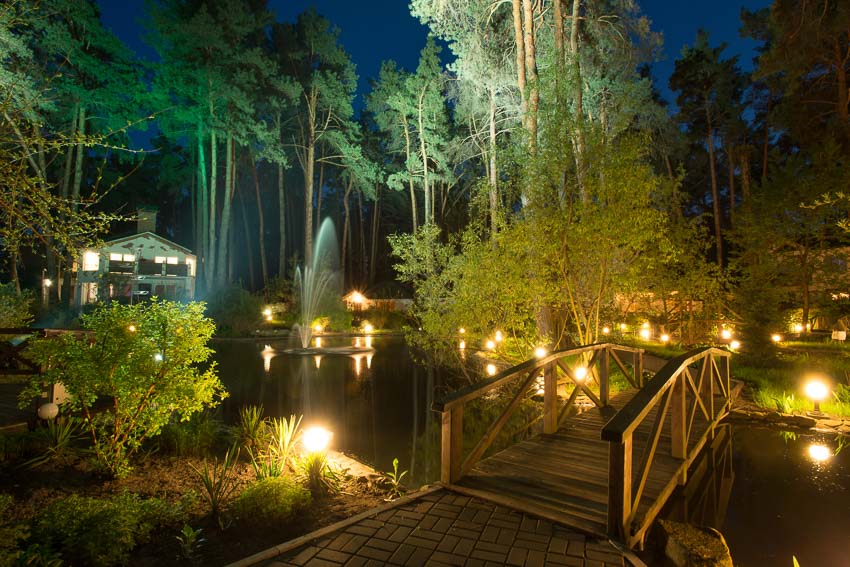There are many reasons to look into landscape lighting. Maybe you want your home to feel safer at night, or you simply want an aesthetic upgrade. Whatever your reason, landscape lighting can add a much-needed finishing touch to your backyard. We’re going over everything there is to know about landscape lighting in this comprehensive guide to help you choose the best lighting for your yard.
An Introduction to Landscape Lighting
Landscape lighting can add aesthetic charm and beauty to your outdoor spaces. Plus, with modern technology, many systems are low-voltage and DIY-friendly for installation.
Landscape lighting can make your home more secure, illuminate walkways, and highlight landscaping features like plants, statues, and ponds.
Understanding the Basics of Landscape Lighting
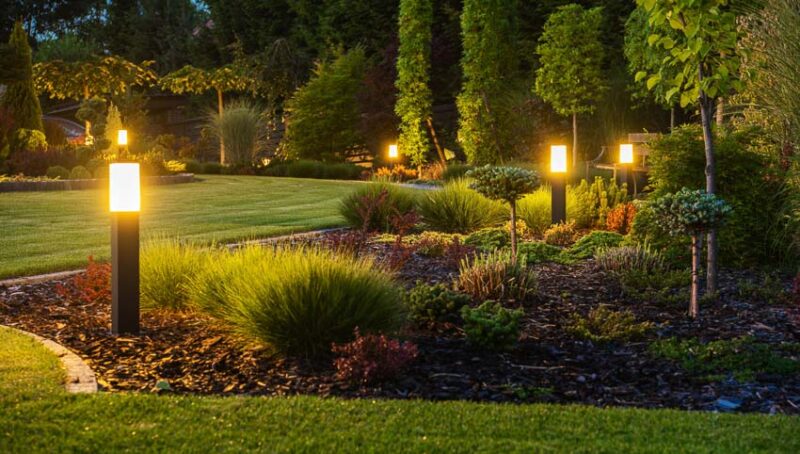
You have several options when you’re choosing landscape lighting, so having a basic understanding of outdoor lighting is very helpful.
There are two main types of landscape lighting— individually powered solar lights and low-voltage landscape lighting systems. Each type has its own advantages and disadvantages, but there are a variety of styles and fixtures for both systems.
Solar Landscape Lighting
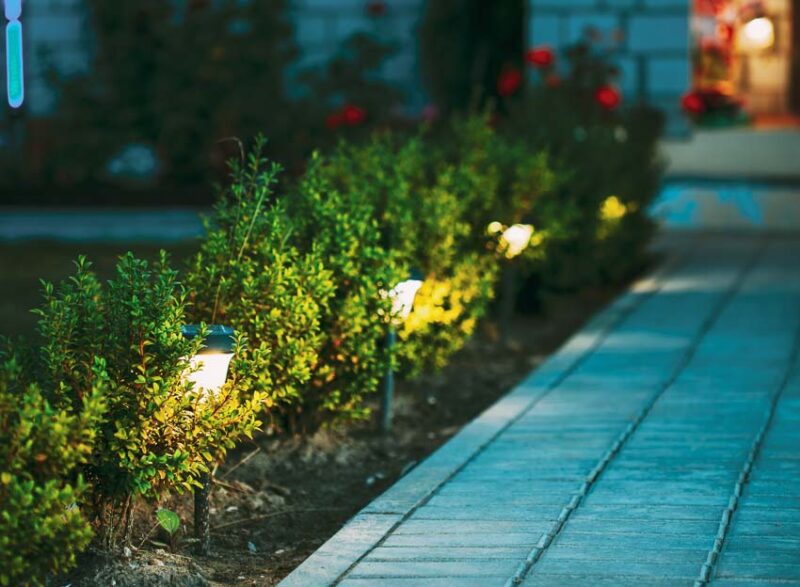
Solar lights are one of the easiest outdoor lighting options to install, and they’re also less expensive than low-voltage lighting systems. These lights don’t cost anything to operate, capturing the sun’s energy and storing it in a battery. Once the sun goes down, they automatically turn on.
However, it’s important to note that they can be inconsistent when there’s not enough sunlight to charge them. Another downside is that you have to replace the batteries every few years.
Low-voltage landscape lights
Low-voltage landscape lighting is powered by a transformer that converts 120 volts to a lower, safe voltage suitable for outdoor use. Outdoor LED lights don’t require much power, and a single transformer can often handle the landscape lights for your whole yard.
There are four main components for low-voltage landscape lighting systems.
- Low-voltage transformer–attached to the exterior of your home and plugged into a GFCI outdoor receptacle
- Low-voltage outdoor light fixtures–there are several types to choose from based on your lighting needs and landscape design
- Low-voltage wire–cable that connects the fixtures to the transformer and supplies power to run the lights
- Wire connections–waterproof connectors are required for making secure connections that can be buried underground
Choosing between the two types of lighting systems can take some time and consideration. If cost and easy installation are the biggest factors, choose solar lights. If you want brighter, more consistent lighting and don’t mind paying more, low-voltage light systems are your best bet.
The Impact of Lighting on Outdoor Aesthetics
Even if your yard is the most well-manicured on the block during the day, it can fall short of expectations once the sun sets. Landscape lighting transforms the visual appeal of your home, raising your property value and making your yard safer and more secure in the process.
Different Types of Landscape Lighting and Fixtures
Different outdoor lighting types offer different applications. There are three main types of landscape lighting, each serving its own purpose— task lighting, ambient lighting, and accent lighting. You can combine fixtures and applications in your yard to create a beautiful and inviting outdoor space.
Task Lighting
Task lighting illuminates specific areas, like pathways, stairs, decks, and grilling areas. Some popular fixtures in this lighting category are floodlights and spotlights.
Ambient Lighting
Ambient lighting makes your yard more secure, sets a specific mood, and adds a decorative touch. This lighting type creates all-over illumination for larger areas of your yard. Also referred to as general lighting, ambient lighting uses softer, wider lights that produce less glare.
Accent Lighting
Accent lights highlight specific features of your yard, like statues, fountains, elaborate shrubs, and architectural details. You can use wide beams of light to cover walls and facades, or spotlights to create focal points.
Landscape Lighting Fixtures
You can combine several lighting fixtures to provide the different lighting types you need for the best overall design. Since there are so many fixture styles to choose from, deciding which ones are best for your yard can be a difficult task.
You can use the following descriptions of light fixtures as a guide when choosing your yard’s landscape lighting layout.
Spotlights
Spotlights, also called directional lights or bullets, are one of the most common lighting fixtures in landscape lighting systems. They’re typically used to highlight specific design features.
You can choose from uplights, downlights, and moonlights, with each style coming in a variety of wattages, beam widths, and bulb types. These lights create shadows and silhouettes, giving your yard a sense of texture or depth.
Area Lights
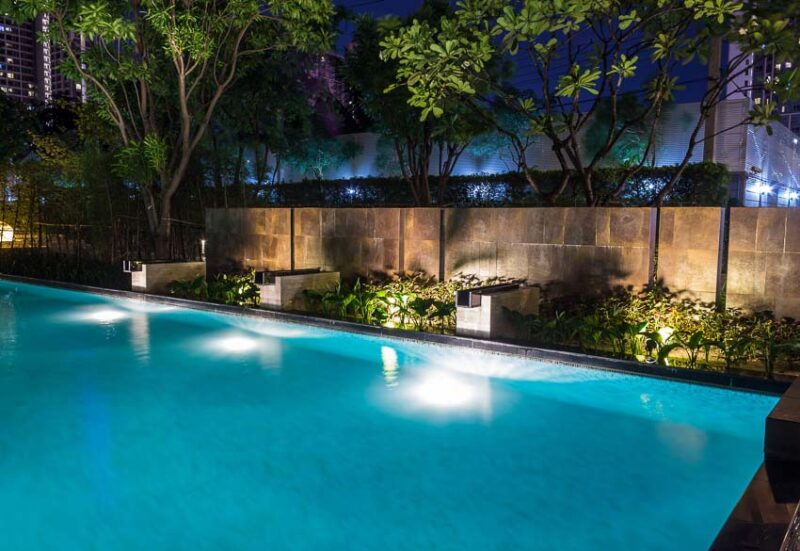
Area lights usually provide all-around lighting, but you can also position them on the edge of a path when you only need 180° of light. You can customize lights that illuminate specific areas like paths, flower gardens, and swimming pools.
Most area lights are best placed in the ground about 14 inches high, but you can also mount them on the side of a building or fence, as well as set them in the ground.
Floodlights
Floodlights have a higher light output than many other types of landscape lighting fixtures thanks to their higher wattage and wide angles. This lighting type is often used when your design calls for broad illumination.
They can be used for both downlighting and uplighting effects on flat surfaces like walls, fences, and facades. Plus, floodlights are also useful for securing your yard or parking area, deterring unwanted guests with a well-lit atmosphere.
Floodlight types include wall wash lights, splash lights, or diffusion lights.
Deck Lights
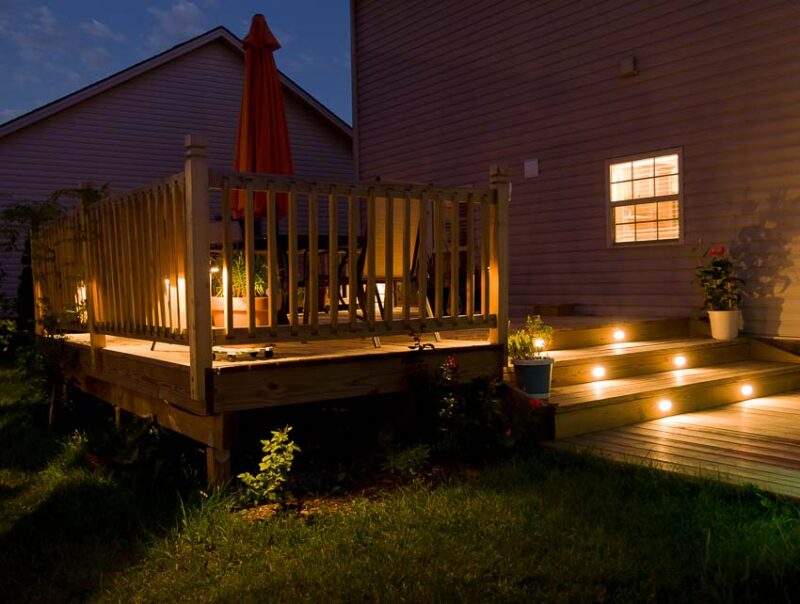
If you have a deck on your property, an easy way to make it safer and more aesthetically pleasing is to add deck lighting. There are several styles of deck lights to choose from, with one of the most popular being cap lights. You could also use side mount lights, under-rail lights, step lights, or recessed deck lights.
Step Lights
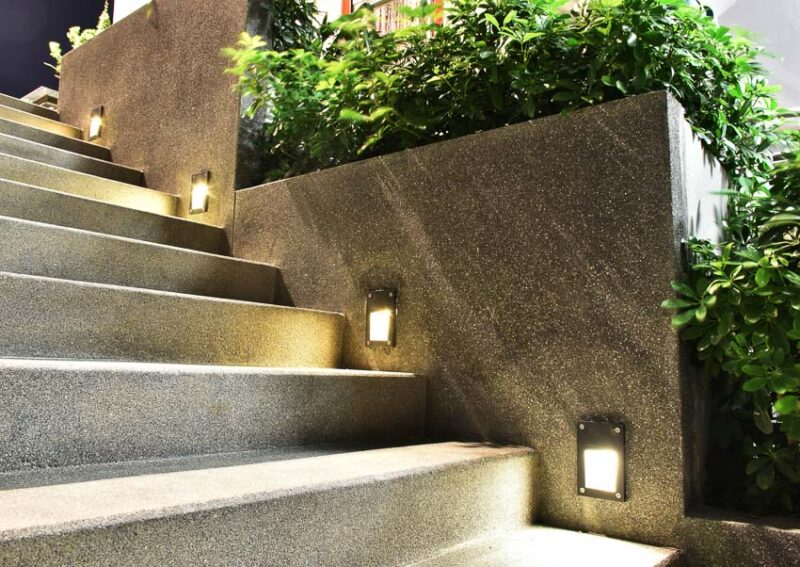
Step lights provide illumination to an outdoor stairway, attaching to the risers of stairs or to side walls, making your steps and surrounding area safer.
Hardscape Lights
Hardscaping features, such as patios, retaining walls, and outdoor fireplaces, can be illuminated in several different ways. For overhangs and capstones, easily hidable lights like strip and bar lights are a popular choice.
Planning and Designing Your Landscape Lighting Layout
Once you choose your lighting system and fixture types, the next (and arguably, more important) step is to plan and design where they will go. Sketch out a plan for your landscape lighting, marking where you will place which lighting fixtures. You can also play around with a landscape design app to help you visualize what your layout will look like.
Key Considerations for Your Design Plan
To start your lighting design, begin by defining your goals and placing your fixtures where you want them. The following are some ideas to help you maximize the light in your outdoor spaces.
House
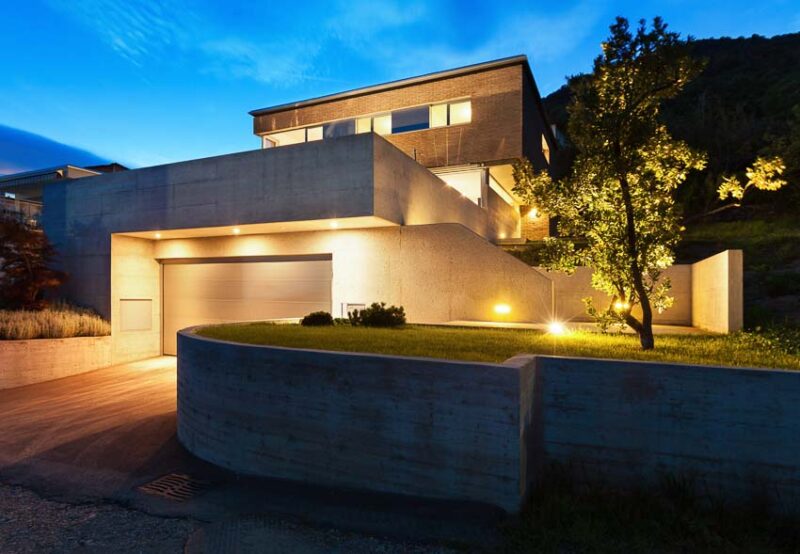
For the outside of your home, a soft wash of light will pick up design features, highlighting your home’s texture and architectural design. Placing lights in the building’s recesses can help illuminate the facade, and spotlights can illuminate your home from the ground up.
Pathways
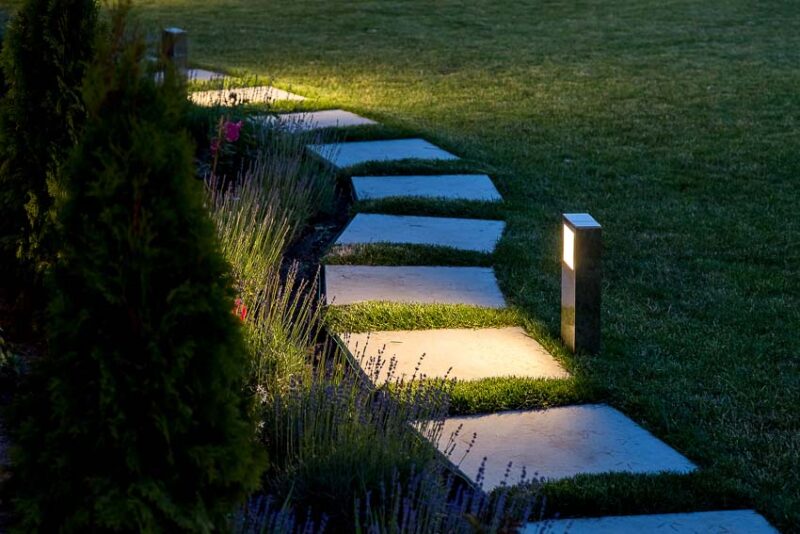
Lit-up pathways are much safer after dark, letting your family or guests move around the yard at night. Most lighting designs call for area lights to be spaced 10 to 15 feet apart, since too much lighting on a path could ruin the ambiance. Another option to light up pathways is to use downlighting installed on trees or other high-up surfaces.
Trees
To draw attention to trees on your property, accent lighting can help create focal points. Large trees need more light, and you can combine various angles and beam sizes to highlight different parts of your trees.
Hardscaping features
To maximize the usability of your outdoor spaces, combine different fixture types for each individual area.
For instance, depending on the design of your patios, decks, fences, and walls, you’ll need different types of light fixtures. For cooking areas, choose task lighting, and to create a comfortable, relaxing atmosphere, install ambient lighting.
Garden Lights
To make your garden areas shine after the sun goes down, use area lights that provide soft, indirect lighting. You can also layer in a spotlight or two to focus on individual plants.
Mapping Out Your Landscape for Lighting
Follow these steps to map out your low-voltage lighting system plan:
- Start by adding the lights in your design where you want them.
- Group fixtures based on how far away they are from the transformer.
- Add up the wattage for each group of light fixtures. Each group should be divided into 100-150 watts each.
- Determine the cable gauge and length that you need.
- Choose the right-sized transformer for your system.
You should have a transformer large enough to power all of your system’s lights. It’s recommended that you stay within 80% of the total watts of your transformer, leaving room to add extra lights if it becomes necessary.
Landscape Lighting Techniques and Applications
It’s easy to become overwhelmed with all of the choices you have to make, but it will be worth it in the end since it will make a difference in how much you use your yard. Here are some tips to keep in mind when you’re starting your landscape lighting plan.
Highlighting Focal Points
To create drama, add visual interest, and even make your yard seem bigger, create focal points in your landscaping. Use lighting to draw focus to individual features, like fountains, trees, and statues.
Remember, landscape lighting is different than lighting something like a parking lot, and it’s easy to overdo it. Often, subtle touches of lighting can create a nice glow while serving multiple purposes.
Layer each area of your lawn using ambient, task, and accent lighting, but try to avoid using all three types in one area.
Creating Shadows and Silhouettes
Moonlights in trees can create shadows and silhouettes, adding texture to your landscaping. You can produce a dramatic effect by casting a tree’s shadow onto a pathway, creating a pattern of interesting visual effects.
Installation and Maintenance of Landscape Lighting

When properly installed, landscape lighting will last for years. Whether installed yourself of by a professional, it also requires regular maintenance to ensure optimal performance and longevity.
DIY vs. Professional Installation
Like most things, installing your own landscape lighting system comes with both advantages and disadvantages.
When you hire a professional, they will have the experience and know-how to tell you exactly where to place landscape lighting to achieve the look you’re going for. On the other hand, you can go the DIY route and save potentially thousands of dollars.
Most DIYers won’t know how to design landscape lighting, so if you plan to do it yourself, it will require a lot of research. Another option is to hire a professional designer and DIY the installation.
Tips for Long-Term Maintenance and Care
Here are some tips for taking care of your landscape lights to ensure they last as long as possible:
- Clean light fixtures regularly
- Check and replace bulbs when necessary
- Re-aim light fixtures that may have shifted over time.
- Trim plants that are blocking the light.
- Remove leaves and debris.
- Regularly inspect your system for moisture-related issues.
Frequently Asked Questions (FAQs) About Landscape Lighting
What is the Best Type of Light Bulb for Landscape Lighting?
LED lights are energy efficient and have a long lifespan, making them the most popular choice for outdoor lighting.
How Many Lights Do I Need for Landscape Lighting?
The number of landscape lights you need depends on the size of your yard, how you use it, and the goals you’re aiming to achieve. It’s easy to overdo it and add too many lights, so remember you can always add more if needed.
Are Solar Landscape Lights a Good Choice?
Solar landscape lights come with all the benefits of any outdoor lighting system, with the added benefits of being low-maintenance and costing next to nothing to operate. However, they’re less reliable than standard lights since adequate sun coverage is needed to power these lights.
How to Troubleshoot Common Landscape Lighting Problems?
The most common landscape lighting problems trace back to connection shorts, as well as problems with bulbs or timers. Be sure to also check that you calculated your transformer’s wattage correctly.
What is the Best Time to Install Landscape Lighting?
The best time to install low-voltage lighting systems is when your plants are dormant in the spring or fall. For solar solutions, there’s no bad time to install, since they don’t require any digging.

